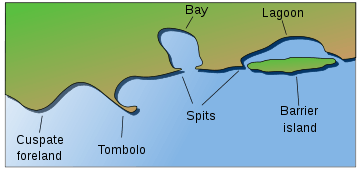Undertow (water waves)
An undertow is the offshore pull that a person standing in the wave-breaking zone can feel most strongly near their feet, as each breaking wave advances towards them.
An undertow is often confused with a rip current.
Oceanography
In physical oceanography, an "undertow" is a steady, low, rather flat, offshore-directed compensation flow. Physically, in the surf zone, passing the breaking point toward the shore, depth-varying Stokes momentum flux is onshore-directed. This mass transport is localised in the upper part of the water column, i.e. at the wave crest. To compensate for the amount of water being transported to the shore this way (and leading to wave setup and a resulting depth-uniform pressure gradient), a second-order, offshore-directed mean current takes place in the lower section of the water column. This flow affects the whole surf zone (and even the shoreface), unlike rip currents.[1] This current is referred as "undertow".
The term undertow is used in scientific coastal oceanography papers.[2][3][4] This flow is as important in coastal sciences as its onshore-directed counterpart outside of the surf zone (Stokes drift and skewed-asymmetric wave transport). These antagonistic flows lead to longshore sand bar formation where the flows converge at the wave breaking point, or in the wave breaking zone.[2][3][4]
Confusion with rip currents
In popular usage, the word "undertow" is sometimes used correctly, in the same sense it is in oceanography. However the term "undertow" is also often used incorrectly, in the mistaken belief that near beaches there is a water flow or current that can pull a person down vertically and hold them underwater until they drown. This misconception stems from a basic lack of knowledge about water currents, and from confusing undertow (which is usually not dangerous) with the more substantial dangers of rip currents. Rip currents also cannot pull a person down, but they can carry a person out beyond the zone of the breaking waves.
In popular use the word "undertow" is sometimes applied to rip currents, which are responsible for the great majority of drownings close to beaches. When a swimmer enters a rip current, it starts to carry the person offshore. If the swimmer understands how to deal with this situation, he or she can easily exit the rip current by swimming at right angles to the flow, in other words swimming parallel to the shore, or by simply treading water or floating. However, if the swimmer does not know these simple solutions, or does not possess the necessary water skills, they may panic and drown, or they may exhaust themselves by trying unsuccessfully to swim directly against the flow.
On the United States Lifesaving Association website it is explained that some uses of the word "undertow" are incorrect:
"A rip current is a horizontal current. Rip currents do not pull people under the water–-they pull people away from shore. Drowning deaths occur when people pulled offshore are unable to keep themselves afloat and swim to shore. This may be due to any combination of fear, panic, exhaustion, or lack of swimming skills."
"In some regions rip currents are referred to by other, incorrect terms such as 'rip tides' and 'undertow'. We encourage exclusive use of the correct term – rip currents. Use of other terms may confuse people and negatively impact public education efforts."[5]
See also
References
- ↑ Lentz, Steven J., Melanie Fewings, Peter Howd, Janet Fredericks, Kent Hathaway, 2008: Observations and a Model of Undertow over the Inner Continental Shelf. J. Phys. Oceanogr., 38, 2341–2357.
- ↑ 2.0 2.1 Garcez Faria, A. F., E. B. Thornton, T. C. Lippman, and T. P. Stanton, 2000: Undertow over a barred beach. Journal of Geophysical Research, 105, 16 999–17 010.
- ↑ 3.0 3.1 Haines, J. W., and A. H. Sallenger, Jr., 1994: Vertical structure of mean cross-shore currents across a barred surf zone. Journal of Geophysical Research, 99, 14 223–14 242.
- ↑ 4.0 4.1 Reniers, A. J. H. M., E. B. Thornton, T. P. Stanton, and J. A. Roelvink, 2004: Vertical flow structure during Sandy Duck: Observations and modeling. Journal of Coastal Engineering., 51, 237–260
- ↑ http://www.usla.org/?page=RIPCURRENTS accessed 2 January 2014
External links
| ||||||||||||||||
| ||||||||||||||||||||||||||||
| |||||||||||||||||||||||||||||||||||||||||||||||||||||||




